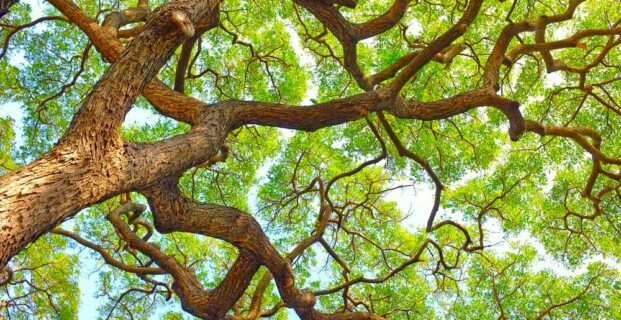Most of us fern-feeling, tree-hugger types already know trees are the longest living organisms on Earth and one of our planet’s greatest natural resources. Trees keep our air supply clean, reduce noise pollution, improve our water quality, help prevent erosion, provide food and building materials, create shade, and bring beauty and a sense of aliveness to our landscapes.
Trees can also save us money. Not only do they give us many products our world has come to rely heavily upon, but they provide us with wind-buffering and shade, reducing our annual heating and cooling costs by billions of dollars. And don’t forget, well-maintained trees and plants increase our property values by up to 10%. With all these benefits, what do we give in return to our backyards and the trees that live in them?
Perhaps we simply give back by trying to not kill them. (Lord knows there’s been enough clear-cutting.) And because we’ve become increasingly aware and concerned about our home, Planet Earth, we’re making concerted efforts to save our environment: we decrease the amount we consume, we decrease the amount we pollute, we practice our 3R’s (reduce, reuse, recycle), and support our favorite environmental organizations (ISF!). But, why would we need a ‘green’ arborist? Isn’t ‘green arborist’ a little redundant?
It turns out the answer is ‘no’ or ‘know.’
A green certified arborist thinks and acts outside of the traditional certified arborist box. Imagine looking at your backyard and brainstorming about how to maintain more of your existing landscape, use minimally intrusive treatments and care methods, employ ecologically sound solutions to existing problems while recycling any resulting green waste! That means no green waste ends up in our ever-widening landfills and any viable wood or logs are utilized for lumber, reducing demand on traditional lumber production.
All arborists will advocate for tree and land vitality, but a green arborist uses an intimate knowledge of ecosystems to come up with solutions that will prevent problems before they begin. Green arborists push for organic fertilizers instead of synthetics, fostering top soil creation and encouraging worms to naturally till and improve the soil. A green arborist is always thinking about conservation and utilizes naturally occurring water sources with progressive ideas about water collection. One example of this water collection is ‘bioswales,’ or swaled drainage courses with gently sloped sides, filled with vegetation, compost and/or riprap. Bioswales are designed to remove silt and pollution from surface runoff water.
Proper pruning, watering, seeding, aeration and selection of the right plants for the right locations help to maintain a vibrant ecosystem. And, never underestimate the powers of mulch! With an intimate knowledge of complex relationships between plants, animals and people, a green arborist considers wildlife corridors, integrated pest management programs, and will advise customers to reduce traditional lawns surrounding broad-leaf trees, (as such lawns require copious amounts of water and fertilizers inside the drip line of the tree, which is detrimental to tree health.)
In our continued vigilance to avoid wasting water, we can get help from a green arborist to set up computer-controlled sprinklers, allowing selective watering rather than drenching an entire landscape. And then there’s the discussion about mycorrhizae and whether they are right for you. In addition to using far less water and reducing fertilizer, green arborists will avoid weed-killers at all costs, and instead employ native grass varieties that can thrive without meticulous care (fine fescue grass seed blends).
Reducing irrigation actually makes roots search for water and in so doing they go deeper, and the deeper they go, the more drought-resistant they become. A green arborist will also steer away from concrete or impervious landscaping in any design phase and instead will encourage the use of pervious materials, so water can be retained onsite to feed trees, plants and the land that supports them. This means avoiding waste from off-site drainage!
The green arborist is about interdependence with trees. Water originating in our national forests provides drinking water for over thousands of communities and millions of individuals. Over the course its life, a single tree can absorb one ton of carbon dioxide. An average American uses about 750 pounds of paper every year, and 94% of homes are built using wood. That means each person uses the equivalent of one 100 foot tall, 16 inch diameter, tree every year for their paper and wood product needs. A single tree produces approximately 260 pounds of oxygen per year. That means two mature trees can supply enough oxygen annually to support a family of four!
Giving back to the trees means finding remedies through pruning diseased limbs or aerating compacted soil. All certified arborists will be looking for dead, dying, diseased, crossed-over, duplicating, or excessive sprouting when evaluating tree health as they work towards promoting trees’ general vitality and vigor. A green certified arborist views a tree and the land that supports it as interconnected, parts of an ecosystem linked to us, and to the planet as a whole. Philosophically speaking, Planet Earth is the green arborist’s customer. Are you ready to make things more reciprocal and give something back to our trees?

